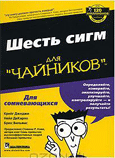Quite a lot of interesting and useful books have been written on the 6 sigma concept. This page contains the most popular publications on this topic.
Six sigma books

Курс на Шесть Сигм. Как General Electric, Motorola и другие ведущие компании мира совершенствуют свое мастерство
This book is one of the first clear guides to the application of the six sigma concept. The first edition of the book was published in 2000. This book shows how companies such as General Electric, Motorola and many others successfully use Six sigma to "fine tune" products and processes, improve production and increase profitability.
This book provides a detailed guide to the application of the Six Sigma concept both manufacturing and service enterprises. The authors of the book, who have collaborated and worked with many enterprises that have implemented Six Sigma, presented a step-by-step guide and practical recommendations in the book. The “Six Sigma Course” will be useful for top management, middle managers, quality and process improvement specialists. The book content focuses on the main steps of the quality improve and the use of Six Sigma tools.

Качество на уровне Шесть Сигма
The book provides a comprehensive and in-depth understanding of the Six Sigma concept. The first part of the book explains how the Six Sigma concept allows an organization to focus on the needs of the customers. The second part contains many examples and explanations for implementing Six Sigma approaches in an organization. The book will be useful both for beginners and for specialists who have been trained in one of the Six Sigma belts. This book can become a desktop guide to the management of the Six Sigma project.

Путь Шести сигм: практическое руководство для команды внедрения
This book contains a little theory and a lot of practice. The authors give a step-by-step guide to the Six Sigma project team on implementing the tools and procedures of this concept. The content of the book is a set of recommendations, explanations and examples for the implementation of Six Sigma methods. Examples of these methods include identifying processes and products that require improvement, using a proactive approach to improve or redesign processes, supporting production, reducing costs, increasing customer satisfaction, etc.
The authors of the book are "veterans" of the Six Sigma concept. They have worked and collaborated with many world-renowned companies that are adherents of the Six Sigma concept. They presented dozens of the most necessary and in-demand tools and techniques in the book for the implementation of the Six Sigma project. The book contains forms of documents and reports on project statistics, among other things.

Что такое "Шесть сигм"? Революционный метод управления качеством
Six Sigma is one of the well-known and popular concepts for improving quality and organizational processes. The authors have tried to explain briefly, but in touch and clearly the basic principles and elements of the Six Sigma concept. The book explains what the Six Sigma concept is, why companies need to apply it and how staff can usefully apply this concept in their own work. The book will be useful to anyone who is interested in methods of improving activities.

Шесть сигм для "чайников"
This book gives an overview of the Six Sigma concept. “Six Sigma for dummies” explains the all fundamental principles, methods and tools of this concept. The authors tell what the Six Sigma concept is and how it works, show the main benefits of this concept for the enterprise and for business, explain the principle of the DMAIC cycle, explain what the yellow, green and black belt mean in the Six Sigma concept, give recommendations for choose and apply the necessary Six Sigma tools, talk about the Six Sigma project, its organization, roles and responsibilities of participants. The book will be useful for readers who are beginning to study the concept of Six Sigma and the organization improving methods.

Шесть сигм для менеджеров
This book will help managers to understand the concept of Six Sigma, will make it possible to simplify the process of learning, interaction, and improving skills in the use of Six Sigma tools in the organization. The book is a step-by-step guide for understanding and applying all facets and aspects of quality improvement based on the Six Sigma concept. The key terms of the Six Sigma concept are explained, the tactics and strategy of using Six Sigma in the organization are considered, practical tips are given to reduce errors during the implementation of this concept, and the explanations are given on the procedures, techniques and methods of Six Sigma.

Бережливое производство плюс шесть сигм в сфере услуг
Service sector enterprises make up a huge part of the economy of developed countries. But the most books on lean production and Six Sigma explain how to apply the methods and techniques of these concepts to industrial enterprises. This book presents approaches and explains how the practices of manufacturing enterprises can be used for the service sector and for the processes of service organizations. The book examines examples of significant improvements in the processes of providing services to companies in various fields of activity – from Lockheed Martin (an American corporation engaged in aeronautics, information technology, military research, security) to Stanford University Hospital (a division of the Stanford Medical University Center). Explanations are given by using the example of these organizations. It explains how they managed to reduce the cost of service from 30 to 60 percent, increase the speed of delivery to 50 percent, increase the volume of services provided to 20 percent, while not increasing the number of their staff.

Новая цель. Как объединить бережливое производство, шесть сигм и теорию ограничений
This book presents how you can achieve outstanding results in the organization work by combining three well-known concepts - Six Sigma, Lean Production and the constraints theory. The content of the book presents the results of applying an integrated approach of these concepts to the processes of the US Navy. The authors call this approach a high-speed approach. It has significantly reduced costs in supply chains and reduced time. The high-speed approach has absorbed all the best of the Six Sigma concepts, Lean Production and Constraint Theory. The book collects and summarizes the experience of using the high-speed approach at enterprises such as Procter & Gamble, ITT, Northrop Grumman and many others. The pages of the book provide explanations and examples of High-Speed Approach for commercial and non-profit organizations, manufacturing enterprises and service sector enterprises. The high-speed approach makes it possible to reduce the delay time, reduce waste, reduce process variability and reduce the cost of products or services. The book will be useful for specialists and managers involved in optimizing activities and improving the quality of work.

Бережливое производство и 6 сигм в логистике. Руководство по оптимизации логистических процессов
Cost reduction, shorter time to market and faster delivery are all the realities of today's competitive business environment. Stocks have ceased to be a necessary condition for the stable operation of the organization, and the strategy of successful operation of the company requires making do with a minimum amount of them. The book explains how to integrate two revolutionary approaches - the Six Sigma concept and Lean Production into logistics processes. The book provides examples and guidelines for reducing inventory, reducing supply volume fluctuations, increasing the speed of delivery and reducing costs in the supply chain. The book will be useful for logistics managers, procurement specialists, inventory managers and managers of logistics activities.

Бережливое производство + шесть сигм. Комбинируя качество шести сигм со скоростью бережливого производства
This book is an advanced program to improve quality, shorten the life cycle and create value for customers. Time and quality are two key characteristics for improving the company's activities. The book explains how to improve the key performance characteristics by combining the two concepts - Six Sigma and Lean production. It provides a step-by-step explanation of the basic elements of Six Sigma and Lean Production. It explanations how to achieve a significant reduction in costs and time delays, reduce the time in the chain from order to products delivery, reduce process variations and eliminate unnecessary losses.
The book will be useful both ordinary employees and all levels managers of organization, as well as people interested in processes and quality improving.
